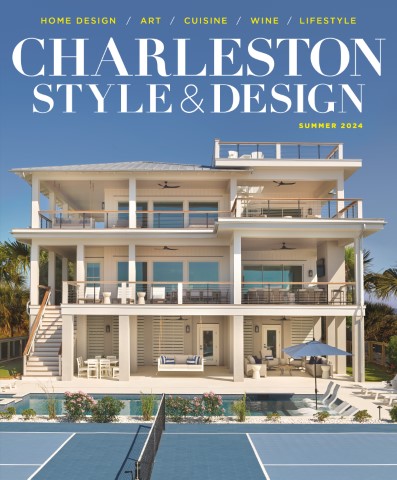Visitors to Charleston frequently assume that every plant on Earth thrives in our landscapes. The truth is that outdoor gardening—even here in paradise—is determined by longitude, latitude and altitude. In other words, geography controls all things botanical and not green thumbs. That is, of course, unless you own a greenhouse.
These buildings, whether modest utilitarian hobby structures or magnificent custom-built glass temples, are nothing more than exceptionally large terrariums. Plant selection, however, is always restricted to the size of the vessel, and balancing the interior environment is rife with trial and error. If you crave a grander, more controlled approach to glass-enclosed gardening, you’ll need an architectural plan.
Although many 21st-century greenhouse designs take the guesswork out of hothouse gardening (some are even configured with programmable climate-control smartphone apps), semblances of greenhouses have been around since the Roman Emperor Tiberius contrived a way to grow cucumbers in winter.
But it wasn’t until the 18th century that greenhouses as we now think of them came into existence. Sailing with nautical explorers such as James Cook, Alexander von Humboldt and Louis Antoine de Bougainville, court-appointed herbalists filled ships’ holds with botanical booty from distant lands solely for the pleasure of kings and queens. These greenhouses were, therefore, first designed as royal grand-scale trophy cases.
While the Dutch pioneered greenhouse design and construction in Europe, colonial America was more influenced by English botanist and herbalist Philip Miller (1691 – 1771), who has an interesting connection to Charleston’s gardening heritage.
Once Miller’s phenomenal opus, The Gardener’s Dictionary Containing the Methods of Cultivating and Improving the Kitchen Fruit and Flower Garden (1731), reached this side of the pond, Charleston’s gardening elite embraced it. Portions of this book also contain lengthy discussions on greenhouse design—clear down to specifics on stoves.
So what does this have to do with modern greenhouses in Charleston? Because of our devotion to our horticultural ancestry, plus our renowned reputation for competitive gardening, it seems fitting that a grand Charleston greenhouse deserves at least a whiff of historical accuracy.
One suggestion is to make use of an 1813 greenhouse illustration by Charlestonian John Izard Middleton (1785 – 1849). Middleton (his father, Arthur, was a signer of the Declaration of Independence), who grew up on Middleton Plantation and later became an internationally respected artist and archaeologist, must have known about Miller. After all, it’s difficult to imagine that he knew nothing about The Gardener’s Dictionary.
Although Middleton’s watercolor, ink and pencil greenhouse drawing was never executed, and was instead probably nothing more than an artistic folly, it’s tempting, as well as appropriate, to speculate on Philip Miller’s influences on Middleton’s design. Although we will never know if Miller’s repeating Roman Doric columns spaced between glass panels inspired Middleton’s incorporation of four of the same into his own plan, this conjecture is at least plausible.
While contemporary greenhouses have no need for Mr. Miller’s suggestions for stoves, much of the 18th-century nomenclature remains the same. In general, the term “greenhouse” refers to a structure that is exclusively meant for the cultivation of plants. But Miller also interchanged this word with “conservatory,” and to modern gardeners this usually conjures up images of massive, ornate Victorian buildings with curved glass and ornate cupolas. Today, it also means an environmentally tempered glass structure that accommodates both plants and people.
If you’re pining for a place to germinate seeds or harvest shallots in the dead of winter, then big box garden centers or catalogs sell reliable greenhouses. But if you yearn to display exotic plants while comfortably lounging among the bromeliads, design and construction become imperative.
Like every potential greenhouse owner, Charleston gardener Lynn Williams had to address these issues during the early stages of planning. Fascinated with botany and horticulture since childhood, she wanted a place to propagate cherished family plants within a stylish structure filled with tropicals and exotics.
Already aware of the existence of high-end greenhouse manufacturers, Williams selected a prefabricated model, even though she could have paid extra to customize an existing plan. She was allowed, however, to design the interior, including shelving and walkways, without additional expense.
When considering a prefabricated design, Williams offers this guidance: You must hire a general contractor to build the foundation and, because of the structural complexities of a glass structure, there must be no error or modification (the manufacturer provides the blueprint). If this sounds daunting, Williams says that in spite of inevitable on-site tweaks, the assembly was a grand adventure and that her greenhouse gives her enormous pleasure.
High-end greenhouse manufacturers, including Hartley Botanic (hartley-botanic.com) and Lord & Burnham (lordandburnham.com), offer many models that complement 18th-century architecture, and both also welcome custom designs. Tell them Misters Miller and Middleton sent you.
PJ Gartin is a freelance garden writer who lives in Charleston.



